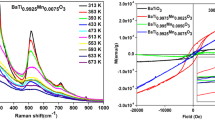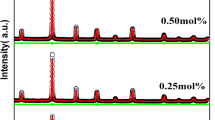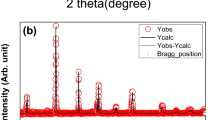Abstract
The ferroelectric and ferromagnetic properties of bare BaTiO3 are weaker than the PbTiO3, which limits its magnetoelectric applications. To overcome these problems, a small amount of Pb was doped in BaTiO3 via a solid-state reaction route to improve the multiferroic properties of the compound. In this way, the modified single-phase Ba1-xPbxTiO3 (0 ≤ x ≤ 0.075) samples have demonstrated improved characteristics and desirable application in the area of microwave tunable devices and multi-layered ceramics capacitors. Rietveld refinement technique ensures that the samples retain their parent perovskite tetragonal phase in P4mm space group. The presence of the metal oxide and several bands were finalized through the Fourier transform infrared (FTIR) spectroscopy study. The elemental composition and the oxygen vacancies were confirmed by the X-ray photoelectron spectroscopy (XPS) studies suggesting two valence states, i.e., Ti3+ and Ti4+ of titanium, in both undoped and doped samples. In addition, XPS spectra also confirm that the Pb-doped BaTiO3 samples are less defective than the undoped ones. The Raman spectra reveal the distorted tetragonal perovskite structure of the samples in the P4mm space group by confirming the four fundamental Raman modes. The dielectric studies in the frequency range of 50 Hz to 5 MHz at room temperature reveal an increase in dielectric constant on Pb doping at the Ba site. The dielectric data analyzed in the framework of the universal dielectric response (UDR) model exhibit no deviation from linear behavior. The a.c. conductivity is found to enhance with the increase in Pb content due to the small polaron hopping conduction mechanism between the Pb and Ba ions. The field-dependent magnetization suggests the diamagnetic nature of the undoped BaTiO3 sample and feeble ferromagnetism in the doped samples. Ferroelectric hysteresis loops reveal linearly raised polarization parameters on Pb content. The existence of both ferromagnetic and ferroelectric phenomena confirms the multiferroic nature of Pb doped BaTiO3 system at room temperature.










Similar content being viewed by others
Data availability
The data that supports the findings of this study are made available from the corresponding author upon reasonable request.
References
W. Eerenstein, N.D. Mathur, J.F. Scott, Multiferroic and magnetoelectric materials. Nature 442, 759–765 (2006). https://doi.org/10.1038/nature05023
S.W. Cheong, M. Mostovoy, Multiferroics : a magnetic twist for ferroelectricity. Nature Mater. 6, 13–20 (2007). https://doi.org/10.1038/nmat1804
N.A. Hill, Why are there so few magnetic ferroelectrics? J. Phys. Chem. B. 104, 6694–6709 (2000). https://doi.org/10.1021/jp000114x
R. Ramesh, N.A. Spaldin, Multiferroics: progress and prospects in thin films. Nanosci. Technol. 3, 20–28 (2009). https://doi.org/10.1142/9789814287005_0003
N.A. Spaldin, S.W. Cheong, R. Ramesh, Multiferroics: past, present, and future. Phys. Today 63, 38–43 (2010). https://doi.org/10.1063/1.3502547
T. Phan, P. Zhang, D. Grinting, S.C. Yu, N.X. Nghia, Influences of annealing temperature on structural characterization and magnetic properties of Mn-doped BaTiO3 ceramics. J. Appl. Phys. 112, 013909–013916 (2012). https://doi.org/10.1063/1.4733691
D. Khomskii, Classifying multiferroics: mechanisms and effects. Physics (2009). https://doi.org/10.1103/physics.2.20
K. Song, N. Ma, Y.K. Mishra, R. Adelung, Y. Yang, Achieving light-induced ultrahigh pyroelectric charge density toward self-powered UV Light detection. Adv. Electron. Mater. 5, 1–8 (2019). https://doi.org/10.1002/aelm.201800413
M.R. Panigrahi, S. Panigrahi, Synthesis and microstructure of Ca-doped BaTiO3 ceramics prepared by high-energy ball-milling. Phys. B Condens. Matter. 404, 4267–4272 (2009). https://doi.org/10.1016/j.physb.2009.08.012
C. Laulhé, F. Hippert, J. Kreisel, M. Maglione, A. Simon, J.L. Hazemann, V. Nassif, EXAFS study of lead-free relaxor ferroelectric BaTi1-x Zrx O3 at the Zr K edge. Phys. Rev. B Phys. Rev. B 74, 014106 (2006). https://doi.org/10.1103/PhysRevB.74.014106
A.K. Kalyani, K. Brajesh, A. Senyshyn, R. Ranjan, Orthorhombic-tetragonal phase coexistence and enhanced piezo-response at room temperature in Zr, Sn, and Hf modified BaTiO3. Appl. Phys. Lett. 104, 252906–252915 (2014). https://doi.org/10.1063/1.4885516
H. Tian, D. Wang, J. Qi, Y. Wang, H. Chan, C. Choy, Synthesis of BaZr0.75Hf0.25O3 by a solid-state reaction technique and characterizations of dielectric properties. J. Alloy Comp. 402, 251–255 (2005). https://doi.org/10.1016/j.jallcom.2005.04.140
W. Xie, P. Li, Q. Zhu, Y. Wang, Y. Zhang, Y. Cai, S. Xu, J. Zhang, Structural origins, tunable photoluminescence governed by impurities and white-light irradiation in transparent Pr3+: BaTiO3 glass-ceramics. CrystEngComm 21, 3613–3618 (2019). https://doi.org/10.1039/c9ce00373h
Q. Sun, Q. Gu, K. Zhu, J. Wang, J. Qiu, Stabilized temperature-dependent dielectric properties of Dy-doped BaTiO3 ceramics derived from sol-hydrothermally synthesized nanopowders. Ceram. Int. 42, 3170–3176 (2016). https://doi.org/10.1016/j.ceramint.2015.10.107
S.K. Jo, J.S. Park, Y.H. Han, Effects of multi-doping of rare-earth oxides on the microstructure and dielectric properties of BaTiO3. J. Alloys Compd. 501, 259–264 (2010). https://doi.org/10.1016/j.jallcom.2010.04.085
I.C. Amaechi, G. Kolhatkar, A.H. Youssef, D. Rawach, S. Sun, A. Ruediger, B-site modified photoferroic Cr3+-doped barium titanate nanoparticles: microwave-assisted hydrothermal synthesis, photocatalytic and electrochemical properties. RSC Adv. 9, 20806–20817 (2019). https://doi.org/10.1039/c9ra03439k
Y. Kuroiwa, S. Aoyagi, A. Sawada, Evidence for Pb-O covalency in tetragonal PbTiO3. Phys. Rev. Lett. 87, 217601–217604 (2001). https://doi.org/10.1103/PhysRevLett.87.217601
B. Noheda, D.E. Cox, G. Shirane, Stability of the monoclinic phase in the ferroelectric perovskite PbZr1-xTixO3. Phys. Rev. B 63, 014103 (2000). https://doi.org/10.1103/PhysRevB.63.014103
L.-F. Zhu, B.-P. Zhang, L. Zhao, J.-F. Li, High piezoelectricity of BaTiO3–CaTiO3–BaSnO3 lead-free ceramics. J. Mater. Chem. C 2, 4764–4771 (2014). https://doi.org/10.1039/c4tc00155a
P. Scherrer, Göttinger Nachrichten Gesell. 2, 98 (1918)
K. Momma, F. Izumi, VESTA: a three-dimensional visualization system for electronic and structural analysis. J. Appl. Crystallogr. 41, 653–658 (2008). https://doi.org/10.1107/S0021889808012016
R. Amin, N. Khatun, S. Sen, Optimization of Pb content in enhancing ferroelectricity and shifting the Tc of BaTiO3 to a higher temperature. J. Appl. Phys. 126, 174105–174110 (2019). https://doi.org/10.1063/1.5116651
A. Rached, M.A. Wederni, K. Khirouni, S. Alaya, R.J. Martín-palma, J. Dhahri, Structural optical and electrical properties of barium titanate. Mater. Chem. Phys. 267, 124600–124611 (2021). https://doi.org/10.1016/j.matchemphys.2021.124600
S. Kumar, V. Luthra, Raman and infrared spectroscopic investigation of the effects of yttrium and tin co-doping in barium titanate. J. Phys. Chem. Solids. 154, 110079–110088 (2021). https://doi.org/10.1016/j.jpcs.2021.110079
M. Arshad, M. Abushad, S. Husain, W. Khan, Investigation of structural, optical and electrical transport properties of yttrium doped La0.7Ca0.3MnO3. Electron. Mater. Lett. 16, 321–331 (2020). https://doi.org/10.1007/s13391-020-00216-1
S.R. Yousefi, O. Ameri, M.S. Niaseri, Control sonochemical parameter to prepare pure Zn0.35Fe2.65O4 nanostructures and study their photocatalytic activity. Ultrson. Sonochem. 58, 104619–104714 (2019). https://doi.org/10.1016/j.ultsonch.2017.05.025
M.G. Aerani, M.S. Niaseri, S. Naseh, Enhanced photodegradation of dye in waste water using iron vanadate nanocomposite; ultrasound-assisted preparation and characterization. Ultrson. Sonochem. 39, 494–503 (2017). https://doi.org/10.1016/j.ultsonch.2019.104619
R.W.M. Kwok, XPS Peak Fitting Program for WIN95/98 XPSPEAK Version 4.1. (2000), http://www.phy.cuhk.edu.hk/~surface/XPSPEAK/
L. Mi, Q. Zhang, H. Wang, Z. Wu, Y. Guo, Y. Li, X. Xiong, K. Liu, W. Fu, Y. Ma, B.Z. Wang, X.W. Qi, Synthesis of BaTiO3 nanoparticles by sol-gel assisted solid phase method and its formation mechanism and photocatalytic activity. Ceram. Int. 46, 10619–10633 (2020). https://doi.org/10.1016/j.ceramint.2020.01.066
F. Davar, M.S. Niasiri, Z. Fereshteh, Synthesis and characterization of SnO2 nanoparticles by thermal decomposition of new inorganic precursor. J. Alloys Compd. 496, 638–643 (2010). https://doi.org/10.1016/j.jallcom.2010.02.152
V.V. Burungale, R.S. Devan, S.A. Pawar, N.S. Harale, V.L. Patil, V.K. Rao, Y.R. Ma, J.E. Ae, J.H. Kim, P.S. Patil, Chemically synthesized PbS nanoparticulate thin films for a rapid NO2 gas sensor. Mater. Sci. Pol. 34, 204–211 (2016). https://doi.org/10.1515/msp-2016-0001
D. Ehre, H. Cohen, V. Lyahovitskaya, I. Lubomirsky, X-ray photoelectron spectroscopy of amorphous and quasiamorphous phases of BaTiO3 and SrTiO3. Phys. Rev. B 77, 184106 (2008). https://doi.org/10.1103/PhysRevB.77.184106
L. Zhou, Y. Zhang, S. Li, Q. Lian, J. Yang, W. Bai, X. Tang, Fe doping effect on the structural, ferroelectric and magnetic properties of polycrystalline BaTi1-xFexO3 ceramics. J Mater. Sci. Mater. Electron. 31, 14487–14493 (2020). https://doi.org/10.1007/s10854-020-04008-z
S.R. Yousefi, H.A. Alshamsi, O. Amiri, M.S. Niasiri, Synthesis, characterization and application of Co/Co3O4 nanocomposites as an effective photocatalyst for discoloration of organic dye contaminants in wastewater and antibacterial properties. J. Moliq. 337, 116405–116410 (2021). https://doi.org/10.1016/j.moliq.2021.116405
C.H. Perry, D.B. Hall, Temperature dependence of the Raman spectrum of BaTiO3. Phys. Rev. Lett. 15, 700–702 (1965). https://doi.org/10.1103/PhysRevLett.15.700
J. Shah, R.K. Kotnala, Induced magnetism and magnetoelectric coupling in ferroelectric BaTiO3 by Cr-doping synthesized by a facile chemical route. J. Mater. Chem. A (2013). https://doi.org/10.1039/c3ta11845b
R. Asiaie, W. Zhu, S.A. Akbar, P.K. Dutta, Characterization of submicron particles of tetragonal BaTiO3. Chem. Mater. 8, 226–234 (1996). https://doi.org/10.1021/cm950327c
M. DiDomenico, S.H. Wemple, S.P.S. Porto, R.P. Bauman, Raman spectrum of single-domain BaTiO3. Phys. Rev. B 174, 522–530 (1968). https://doi.org/10.1103/PhysRev.174.522
A. Jain, R. Saroha, M. Pastor, A.K. Jha, A.K. Panwar, Effect of sintering duration on structural and electrical properties of Ba0.9Sr0.1Ti0.96Zr0.04O3. Curr. Appl. Phys. 16, S37–S62 (2016). https://doi.org/10.1016/j.cap.2016.04.022
A. Jain, A.K. Panwar, Synergetic effect of rare-earths doping on the microstructural and electrical properties of Sr and Ca co-doped BaTiO3 nanoparticles. Ceram. Int. 46, 10270–10278 (2020). https://doi.org/10.1016/j.ceramint.2020.01.020
M. Iwamoto, Maxwell—Wagner effect, in Encyclopedia of nanotechnology. ed. by B. Bhushan (Dordrecht, Springer, 2015), pp.1–13. https://doi.org/10.1007/978-94-007-6178-0
M.S. Alkathy, A. Hezam, K.S.D. Manoja, J. Wang, C. Cheng, K. Byrappa, K.C.J. Raju, Effect of sintering temperature on structural, electrical, and ferroelectric properties of lanthanum and sodium co-substituted barium titanate ceramics. J. Alloys Compd. 762, 49–61 (2018). https://doi.org/10.1016/j.jallcom.2018.05.138
M. Arshad, W. Khan, M. Abushad, M. Nadeem, S. Husain, A. Ansari, V.K. Chakradhary, Correlation between structure, dielectric and multiferroic properties of lead free Ni modified BaTiO3solid solution. Ceram. Int. 46, 27336–27351 (2020). https://doi.org/10.1016/j.ceramint.2020.07.219
K. Omri, S. Gouadaria, Dielectric investigation and effect of low copper doping on optical and morphology properties of ZO–Cu nanoparticles. J. Mater. Sci. Mater. Electron. 32, 17021–17031 (2021). https://doi.org/10.1007/s10854-021-06268
S. Butte, K.R. Kambale, A. Ghorphade, A. Halikar, R. Gaikwad, H. Panda, Significant improvement in Curie temperature and piezoelectric properties of BaTiO3 with minimum Pb addition. J. Asian Ceram. Soc. 7, 407–416 (2019). https://doi.org/10.1080/21870764.2019
N. Sareecha, W.A. Shah, A. Maqsood, M.A. Rehman, M.L. Mirza, Fabrication and electrical investigations of Pb-doped BaTiO3 ceramics. Mater. Chem. Phys. 193, 42–49 (2017). https://doi.org/10.1016/j.matchemphys.2017.124600
C.G. Koops, On the dispersion of resistivity and dielectric constant of some semiconductors at audio frequencies. Phys. Rev. 83, 121–124 (1951). https://doi.org/10.1103/PhysRev.83.121
A. Ahad, M.A. Taher, M.K. Das, M.Z. Rahman, M.N.I. Khan, Effect of Y substitution on magnetic and transport properties of Ba0.95La0.05Ti1−xYxO3 ceramics. Results Phys. 12, 1925–1932 (2019). https://doi.org/10.1016/j.rinp.2019.01.072
T. Sareein, P. Baipaywad, W. Chaiammad, S. Annanta, X. Tan, R. Yimnirun, Dielectric aging behaviour of A-site hybrid-doped BaTiO3 ceramics. Curr. Appl. Phys. 11, S90–S94 (2011). https://doi.org/10.1016/j.cap.2011.03.018
A.K. Jonscher, The ‘Universal’ dielectric response. Nature 267, 673–679 (1977). https://doi.org/10.1038/267673a0
K. Omri, I. Najeh, L.E. Mir, Influence of annealing temperature on the microstructure and dielectric properties of ZnO nanoparticles. Ceram. Int. 42, 89490–89848 (2016). https://doi.org/10.1016/j.ceramint.2016.02.151
S. Layek, H.C. Verma, Magnetic and dielectric properties of multiferroic BiFeO3 nanoparticles synthesized by a novel citrate combustion method. Adv. Mater. Lett. 3, 533–538 (2012). https://doi.org/10.5185/amlett.2012.icnano.242
S. Manzoor, S. Husain, Influence of Zn doping on structural, optical and dielectric properties of LaFeO3. Mater. Res. Express 5, 055009–055012 (2018)
M. Nadeem, W. Khan, S. Khan, S. Husain, A. Ansari, Tailoring dielectric properties and multiferroic behavior of nanocrystalline BiFeO3 via Ni doping. J. Appl. Phys. 124, 164105–164109 (2018). https://doi.org/10.1063/1.5050946
Z. Zhao, V. Buscaglia, M. Viviani, M.T. Buscaglia, L. Mitoseriu, A. Testino, M. Nygren, M. Johnsson, P. Nanni, Grain-size effects on the ferroelectric behavior of dense nanocrystalline BaTiO3 ceramics. Phys. Rev. B - Condens. Mater. Phys. 70, 1–8 (2004). https://doi.org/10.1103/PhysRevB.70.024107
K. Keizer, A.J. Burggr, Grain size effects on the ferroelectric-paraelectric transition, the dielectric constant, and the lattice parameters in lanthana-substituted lead titanate. Phys. Stat. Sol. (a) 26, 561–569 (1974). https://doi.org/10.1002/pssa.2210260220
V. Shuvaeva, Y. Azuma, K. Yagi, H. Terauchi, R. Vedrinski, V. Komarov, H. Kasatani, Ti off-center displacements in Ba1-xSrxTiO3 studies by EXAFS. Phys. Rev. B 62, 2969–2972 (2000). https://doi.org/10.1103/PhysRevB.62.2969
M. Arshad, W. Khan, P. Rajput, M. Kumar, M. Abushad, S. Hussain, Synchrotron based x-ray absorption spectroscopy investigation and temperature dependent ferroelectric properties of Ni doped BaTiO3 nanostructures. Ceram. Int. 48, 14156–14165 (2022). https://doi.org/10.1016/j.ceramint.2022.01.302
N.V. Dang, T.D. Thanh, L.V. Hong, V.D. Lam, T.L. Phan, Structural, optical and magnetic properties of polycrystalline BaTi1-xFexO3 ceramics. J. Appl. Phys. 110, 043914–043917 (2011). https://doi.org/10.1063/1.3625235
S.K. Das, R.N. Mishra, B.K. Roul, Magnetic and ferroelectric properties of Ni doped BaTiO3. Solid State Commun. 191, 19–24 (2014). https://doi.org/10.1016/j.ssc.2014.04.001
G.Z. Xing, Y.H. Lu, Y.F. Tian, J.B. Yi, C.C. Lim, Y.F. Li, G.P. Li, D.D. Wang, B. Yao, J. Ding, Y.P. Feng, T. Wu, Defect-induced magnetism in undoped wide band gap oxides: zinc vacancies in ZnO as an example. AIP Adv. (2011). https://doi.org/10.1063/1.3609964
S. Duhalde, M.F. Vignolo, F. Golmar, C. Chiliotte, C.E.R. Torres, L.A. Errico, A.F. Cabrera, M. Rentería, F.H. Sánchez, M. Weissmann, Appearance of room-temperature ferromagnetism in Cu-doped TiO2-δ films. Phys. Rev. B 72, 20–23 (2005). https://doi.org/10.1103/PhysRevB.72.161313
Acknowledgements
The authors are also thankful to Professor Shakeel Khan, Department of Applied Physics, AMU, Aligarh for providing the FTIR and dielectric measurement facilities.
Author information
Authors and Affiliations
Corresponding author
Ethics declarations
Conflict of interest
The authors have no conflict of interest to disclose.
Additional information
Publisher's Note
Springer Nature remains neutral with regard to jurisdictional claims in published maps and institutional affiliations.
Rights and permissions
Springer Nature or its licensor (e.g. a society or other partner) holds exclusive rights to this article under a publishing agreement with the author(s) or other rightsholder(s); author self-archiving of the accepted manuscript version of this article is solely governed by the terms of such publishing agreement and applicable law.
About this article
Cite this article
Arshad, M., Abushad, M., Azhar, M. et al. Origin of enhanced dielectric and multiferroic properties in Pb-doped BaTiO3 ceramics. Appl. Phys. A 128, 1123 (2022). https://doi.org/10.1007/s00339-022-06239-9
Received:
Accepted:
Published:
DOI: https://doi.org/10.1007/s00339-022-06239-9




